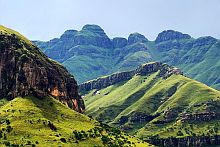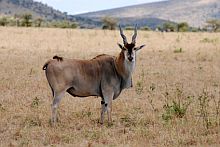SAEON plays vital role in monitoring SA’s premier water engine
|
The grassland biome, which covers 29% of South Africa’s surface area, has provided the fabric upon which the industrial heartland of the country has developed.
The grassland biome is the mainstay of crop and livestock agriculture in the country, supports most of the country’s rural population, functions as the country’s most important water-manufacturing engine, and contains globally significant biodiversity.
Yet 30 % of the biome has already been irretrievably transformed. There is a pressing need to conserve what remains of this biome and to ensure continued delivery of its essential ecosystem services.
A century of investigation
Why is this biome grassland and not some other form of vegetation such as savanna, forest, karoo, or fynbos?
This question remains at the cutting edge of vegetation theory despite close on a century of comment and investigation. Fire is an integral component of this discussion. Many argue that the grassland biome is simply a consequence of frequent fires precluding woody vegetation. In theory, this is easily tested – preclude fire and measure the consequent vegetation changes.
There are, however, two simple stumbling blocks. Vegetation change may be slow, thus fire would have to be precluded for an extended period, which is not easy in a fire-prone environment and requires a dedicated effort.
This country is fortunate in having had a handful of visionary ecologists before our time who initiated such experiments 50 or more years ago. It is further fortunate that research was part of a government department’s responsibilities, such that adequate resources were available for maintaining these experiments. Two such efforts are located in the Drakensberg region of KwaZulu-Natal at Cathedral Peak and at nThabamhlope. These efforts have experienced different histories since their establishment that offer valuable insights about the relation between fire and vegetation dynamics.
A new research programme has been initiated through a research partnership comprising SAEON, Ezemvelo KZN Wildlife and the University of KwaZulu-Natal. The project is funded by the National Research Foundation through a grant to Prof Tim O’Connor.
Cathedral Peak and nThabamhlope
The SAEON-led study focuses on Cathedral Peak and nThabamhlope. Cathedral Peak was home to one of the outstanding achievements of South African science – the study of long-term water yield from grassland in response to fire management and afforestation.
nThabamhlope used to be a research farm of the KwaZulu-Natal Department of Agriculture until the land was returned to the local community in the 1990s. John Scott and Oliver West established two plots in 1939 that were completely protected from fire and grazing, and described the vegetation at that time. These plots were re-measured by Bobby Westfall, Colin and Terry Everson in 1979, after forty years of protection. At this time both had established closed canopies of woody plants.
Much ground has already been covered in the programme as vegetation change has been studied in detail. Ed Granger completed his PhD on the first twenty years of vegetation succession. Keryn Adcock undertook her MSc on the next twenty odd years of change. These efforts not only documented the rate and pattern of change, but offered well-supported hypotheses about vegetation succession in this environment.
The current MSc research effort continues this tradition to provide a 60-year chronicle of vegetation change. An accidental fire in 2008 has provided a further opportunity to assess directly the impact of fire on this vegetation succession. Hypotheses of the original workers are being refined.
Forces of change
A start has been made with the study of long-term patterns in the fire regime at a landscape scale as fire is a main ecosystem driver. A robust foundation exists for understanding vegetation changes. Fire has been precluded for up to 60 years at Cathedral Peak, Giants Castle and nThabamhlope, thereby offering an unparalleled opportunity to examine succession from grassland to woodland/forest.
Aerial photographs are another invaluable source of evidence of the ingress of woody elements into grassland. They offer a 70 -year history that can be extended to 110 years using photographs from the Boer War – the wooded thickets on the flanks of Spioenkop were absent then. Study of bush encroachment on outlying hills in relation to management and topographic influences on fire may presage what lies ahead for the Drakensberg.
Herbaceous vegetation has also received close attention in the past. Additional long-term fire and grazing experiments, plus numerous fence-line contrasts between the protected area and areas accessed by livestock, will allow a comprehensive assessment of forces of change of this vegetation component. Altitudinal transects will be consolidated from existing plots of herbaceous vegetation in order to examine altitudinal shifts in vegetation, especially the expected expansion of C3 grasses and other plants at lower altitude.
Changes in fire regime and vegetation would affect the quality and quantity of resources on which large mammalian herbivores subsist. There is concern about oribi, klipspringer may already have been lost, red hartebeest have been unsuccessfully reintroduced, eland and bushbuck thrive, while the well-being of grey rhebuck and mountain reedbuck is unknown. Research continues on flagship species such as vultures, while a recent broad assessment of biodiversity might serve as a basis for examining security of biodiversity in this World Heritage Site and its surrounds.
The above-described efforts are simply the first steps in addressing a complex system that capitalises on past research and monitoring. In the near future it is hoped that greater attention can be paid to the influence of land use on ecosystem services.
Effect of different drivers of change
The aim of the study is not simply to show that change is occurring, but to understand the effect of different drivers of change on ecosystem structure and functioning. This, to some extent, is an important contribution of this work as most global change studies focus mainly on establishing that change is taking place. Understanding the actual contribution of individual factors to change is important because it would lead to a targeted approach in terms of mitigation.
Another important impact of the study would be its use of ecosystem as a unit of analysis. Although ecosystems are complex and therefore predicting their response under ‘natural’ conditions is challenging enough without the added complexity of global change impacts, there is a pressing need to aggregate understanding of responses of components or processes into an understanding of ecosystem-level response. Failure to include the complexity of ecosystem structure and functioning increases the risk of erroneous prediction of global change impacts. The research will also yield an understanding of biome shifts (contraction), biodiversity and the threat of alien invasive plants, biogeochemical cycling and productivity, including carbon flux, hydrological functioning and sediments, as well as fire regimes.
The research is also expected to contribute immensely to the understanding of hydrological functioning of catchments and the associated ecosystems; and model climate change, land use, fire, invasive plants, river management, and nutrient loading impact on them.
Related content: SAEON Ndlovu - 'Proudly South African' in the Swiss Alps







